|
MicroStation Tools
 Batch
DGN (V8i)
Download
Buy Now Batch
DGN (V8i)
Download
Buy Now
 About About
This application offers quick and easy printing and converting of batches of MicroStation documents; an indispensable tool to every CAD manager and MicroStation user.
The application features several modes to select files to work with, notably: drag and drop,
loading Excel lists, or searching for files in folders.
It can also convert batches of MicroStation documents to DWG, DXF,
DGN V7 and DGN V8 file formats.
The user also has the option of zipping the selected files in case they have to be e-mailed. This feature helps users quickly prepare files to be sent to customers or suppliers and does not need the presence of MicroStation.
The application is designed to save time and money, it is easy to use and
preserves user's options between sessions.
 Features and Benefits Features and Benefits
- High performance: average print creation speed
21 drawings/min*
- Four efficient modes
to select files to work with:
1.
drag and drop files from Windows Explorer,
2. load file list from Excel,
3. search for files in folders,
4. print active document only.
- Print using a specified paper size for all
files in the
batch.
- Batch conversion to DWG, DXF, DGN V7 and
DGN V8 file formats.
- Drawing orientation options: portrait or landscape.
- User has the option to print the active
model, all design models, all drawing
models, all sheet models or all models.
- Uses a spooler and sends
all print files from the batch together so
that it prevents a mix-up with print files sent from other sources on the
network.
- Zip selected files to group them in a
single file or zip them individually.
- All settings are saved between sessions.
 Usage Usage
-Start the application by browsing the
menu: All Programs, Office Optimum, Batch
DGN. Aso start MicroStation if is not already running.
Then, please
follow these simple instructions describing
each item on Batch DGN interface:
-MicroStation Files
Selection; there are 4 modes
to select files to be printed, converted or
zipped. Select the
tab corresponding to your needs:
1.Drag and Drop files from Windows Explorer to
the program interface.
If you change your mind, you can double click to remove
some of the files from the list.
Note that if you drag and drop files of
incompatible format they will be skipped
when the batch process starts.
The list can be sorted by clicking on the column tab.
2.Load File List from an Excel file. To
use this mode you first need to have the
MicroStation document list open in Excel, then to click
Select Excel File button; a window will
pop-up showing all open Excel files. Select
the appropriate Excel file. Next, enter the sheet
number where the list is located in the
Excel file (ex.: enter 1 if the list is in
the first sheet). Specify the column to read
from in the From Column field by
entering the column letter or column number.
If the paths of the MicroStation documents are included in the
list, select Document locations are specified
in the selected Excel file option. This
is an example of such list:
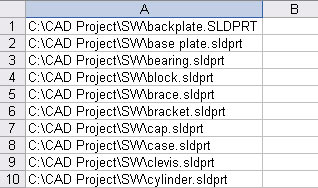
If the paths of the documents are not included in the list,
select Use folder option and click
Select Folder button to browse to the
folder where MicroStation documents are located.
This is an example of such list:
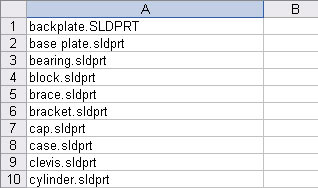
At the end of the batch process, the cells
in the Excel file will be marked in green
and red; files successfully printed will be
marked in green, files not found in red and
duplicates will be left unchanged.
Your Excel lists may contain duplicate
file names. You can control whether to print
duplicates or not by selecting Yes
or No in the Print Duplicates
menu. 3.Search Folder mode. To use this
mode, first decide if you need to check the
Include SubFolders or not. Then,
click Select folder button and browse
to the folder where SolidWorks documents are located.
The application will search for MicroStation
documents. All documents found will be listed in the
lower window. You can click Select folder
button again and add other files to the
list. If you wish, you can double click to remove
some of the files from the list.
Files can be re-arranged in the list by dragging them, so that the prints come out in the desired order. The list can also be sorted by clicking on the column tab.
4.All Open Documents mode allows you to process all currently
open MicroStation document files. You have the option to close
all files when finished (without saving).
5.Active Document mode prints only the active
MicroStation
document.
-First, select batch Print,
batch Convert or Zip mode by clinking the
appropriate tab.
-Print Devices window lists the
available printers and plotters. Click to
select the desired item in the list.
-Media Sizes window lists the
available paper sizes for the selected print
device. Click to select the desired
item in the list. All selected documents
will be printed with the same paper size.
You can, however, check Use size saved in
document check box to use the paper size
setting last saved in each MicroStation
document.
-In Convert mode you can select DWG, DXF,
IGES, JPG, PDF, STL, STEP and TIF
file formats.
You can
convert to more than one file format in the
same batch process, although if you convert
you cannot print in the same time. You can,
however, use the same file selection to
convert and then to print or vice versa.
If the Use initial MicroStation file
location option is selected, the newly created files will be saved in the
same directory as the MicroStation files.
If the Use folder option is selected
you must provide a valid folder. You can
click on Select folder button to
select an existing folder or to create a new
folder where the converted files will be
saved. The Use folder option is
especially needed when the MicroStation files
reside in ready only folder, or in a PLM
system like SAP PLM. Note that existing files with identical
name and extension will be
overwritten in the batch convert process.
-In Zip mode you can zip selected files to group them in a single file or zip them individually.
Zipping files will minimize their size and
prepare them to be sent by e-mail.
-Next, select the Drawing Orientation.
The Auto Select option will
automatically select portrait or landscape orientation
according to each drawing format:
-Enter the Number of copies.
-Print
Model Options allows printing of the
active model of each selected document, or
specific types of models in each drawing, or
all models of each drawing in the batch.
-Click Start Batch button to start
the batch printing/converting.
The options selected will be applied to all
documents. You can click the Exit/Cancel button to stop a running batch process.
- Confirm each print serves for
pausing the batch process before printing
(or converting) and giving the user the
chance to modify or skip certain
documents from the batch process. When this
check box is on, after opening each drawing,
the user can verify the document, change it,
then decide to print (convert) it or skip it
and go to the next document.
 Screenshots Screenshots
Drag and Drop mode
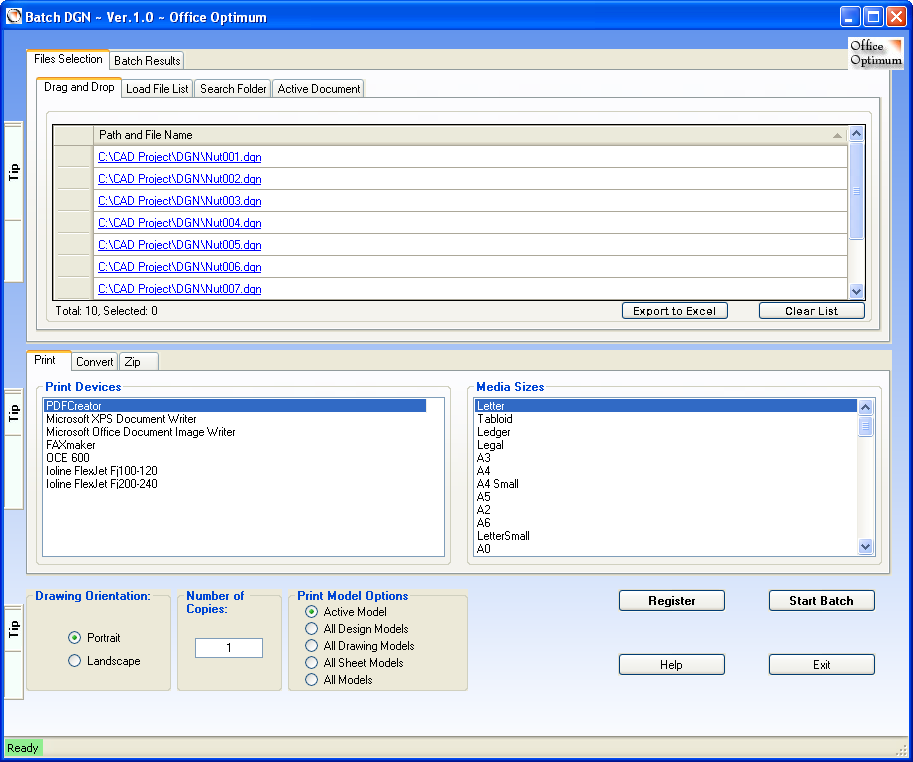
Load File List mode
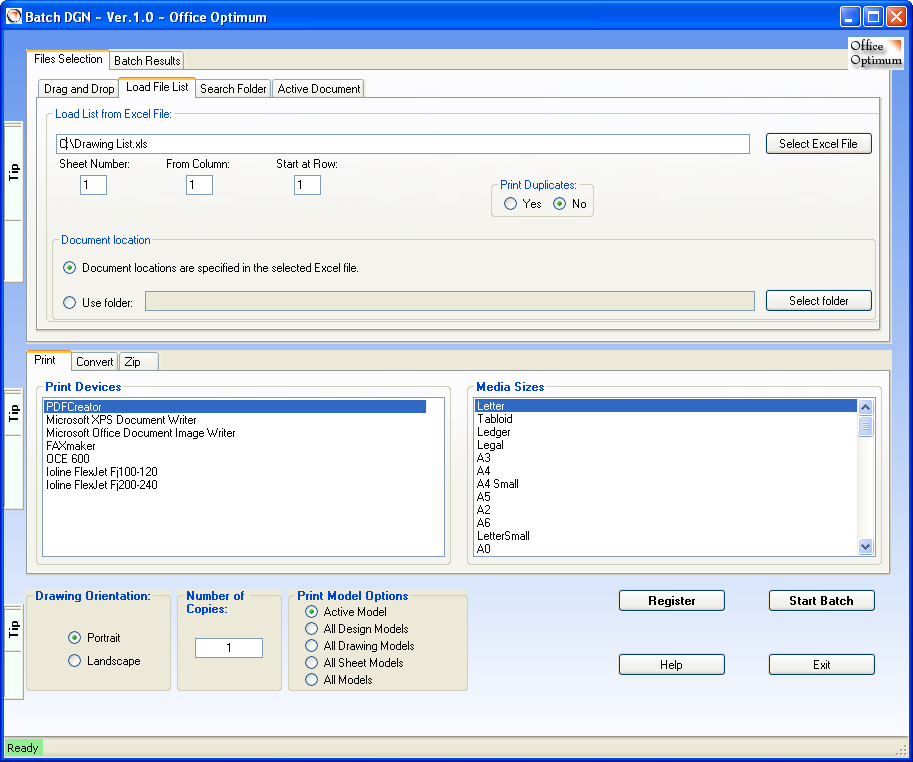
Search Folder mode

Convert mode
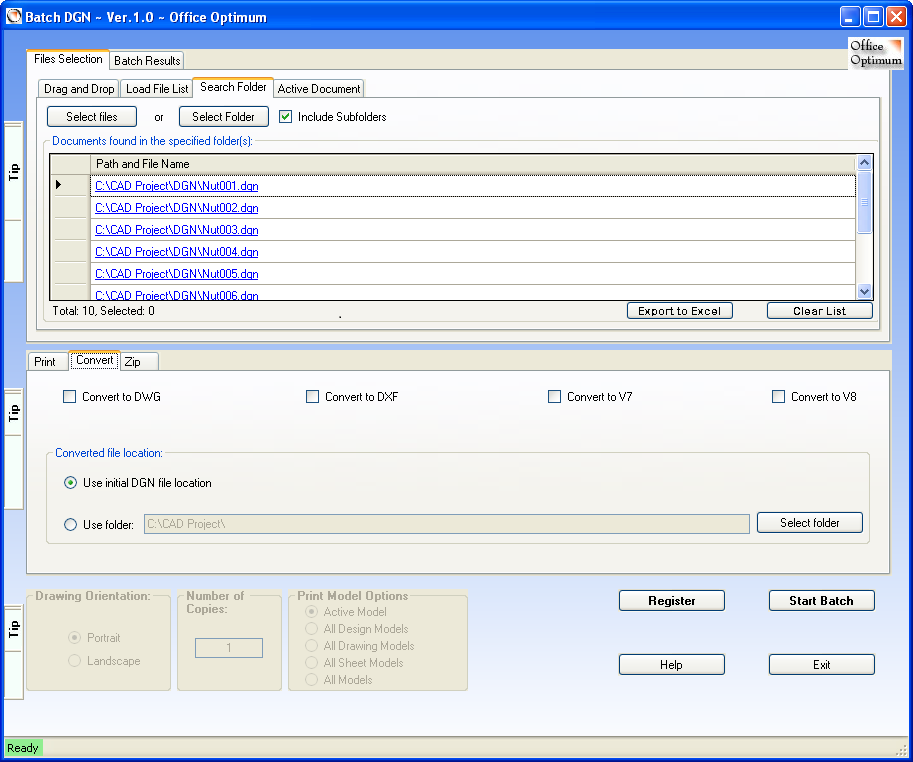
Zip mode
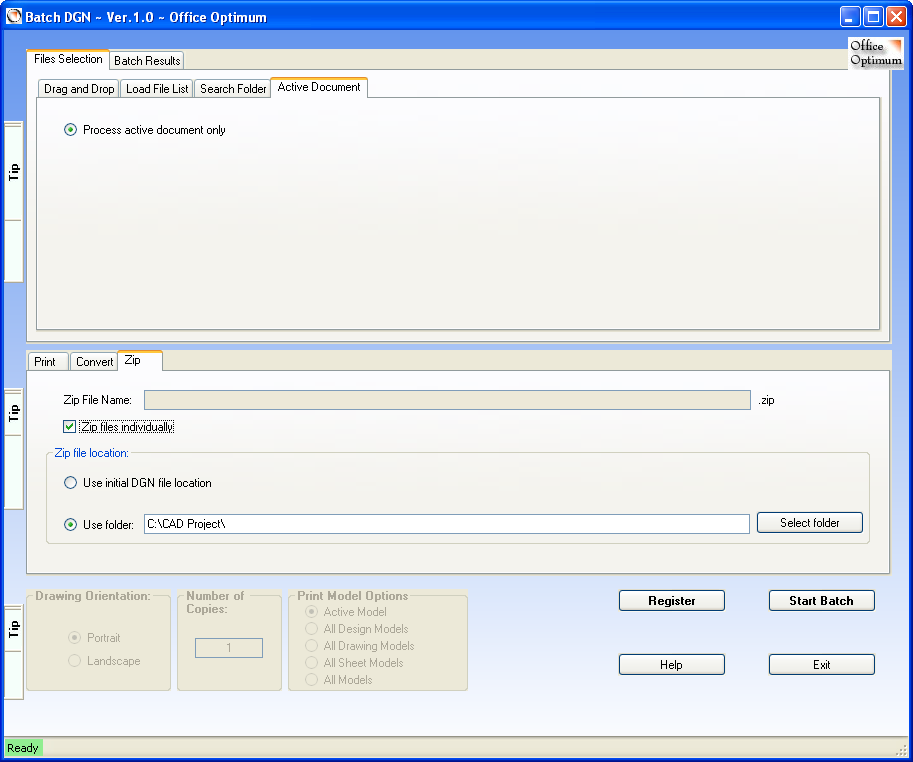
Batch Results
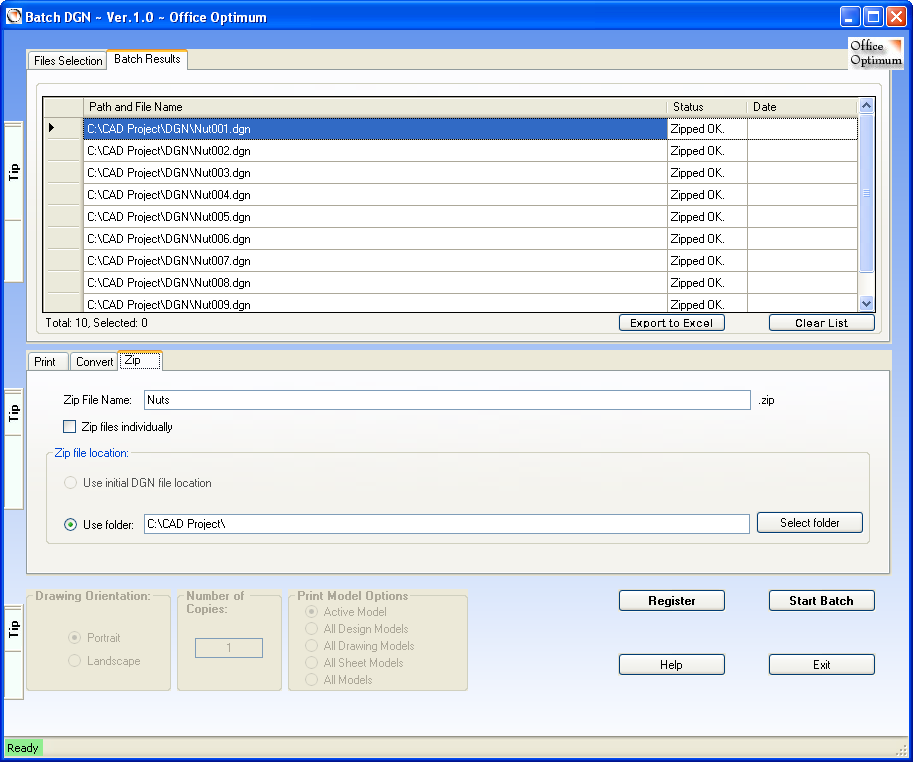
Note that in order to use Batch DGN you need to first start
MicroStation. At start up Batch DGN will try to find a
running instance of your MicroStation software.
* Speed varies depending on factors like file size, network and
computer speed.
- Pad file location:
https://www.officeoptimum.com/MicroStation/BatchDGN/pad_file.xml
 System requirements System requirements
MicroStation V8i
Operating System Windows 2000, Windows NT, Windows XP (32 or 64 bit), Windows Vista, Windows 7 (32 or 64 bit).
Microsoft Excel 2000, XP or later
|

